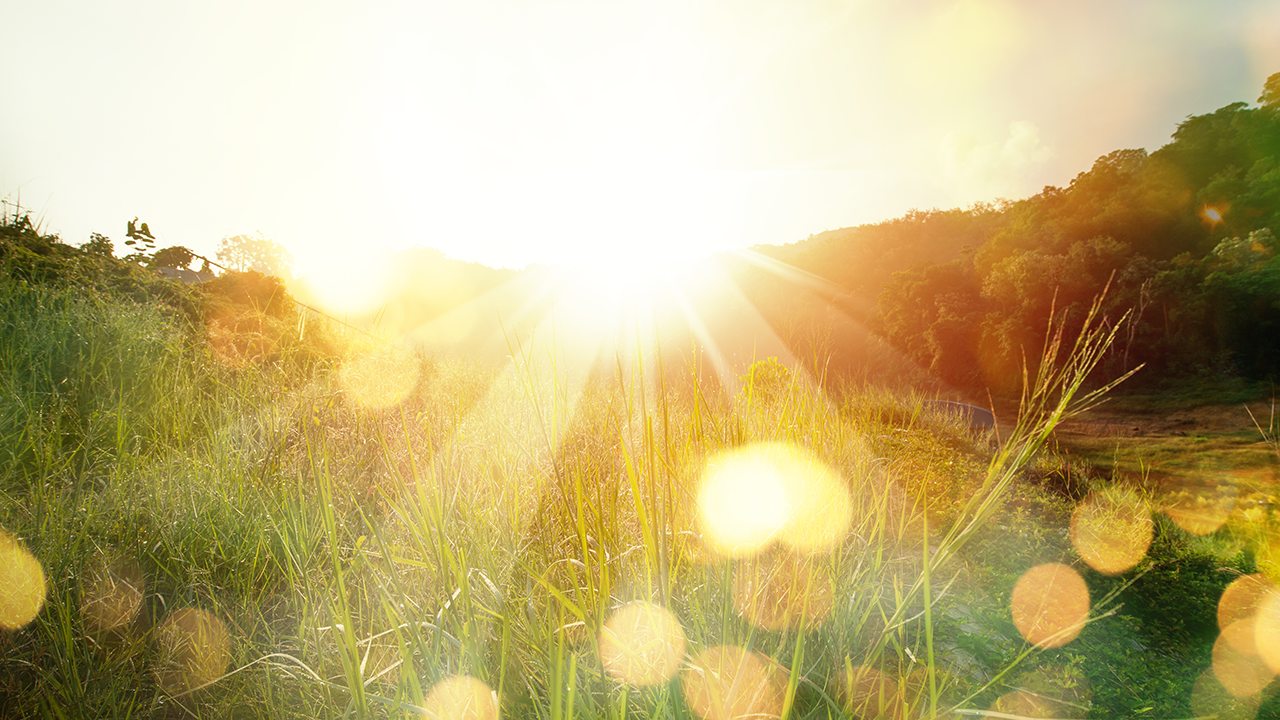A Guide to Shortwave Solar Radiation and Its Derivatives
Agricultural production is a complex process that involves a variety of environmental factors. Shortwave solar radiation, the primary driver of photosynthesis, is one of the most important environmental factors impacting production.
Below, we’ll explore shortwave solar radiation and its derivatives in more detail. We’ll also review how to measure these critical variables and use the data to improve crop health.
What Is Solar Radiation?
Solar radiation is the energy emitted by the sun to the entire solar system. This energy travels 150 million kilometers to Earth, determining climate and allowing life on our planet. Within the full spectrum of wavelengths emitted by the sun, a portion (between 100 nm to 300 nm) is captured by Earth’s atmosphere before hitting the ground. Shortwave radiation (300 nm to 3,000 nm) reaches the surface in diffuse and direct irradiances.
Arable uses the shortwave measurements (300–3,000 nm) to calculate the number of light molecules in this range that the plant receives in a second, the amount of energy that a plant gets in a day (Daily Light Integral), and the time the plant is exposed to this level of light (Sunshine Duration).
Other essential factors to know are the location and movement of the sun relative to the crop. These considerations, which indicate where the sun appears directly overhead at solar noon (the point when the sun reaches its highest altitude), require knowledge of the latitude and day of the year.1
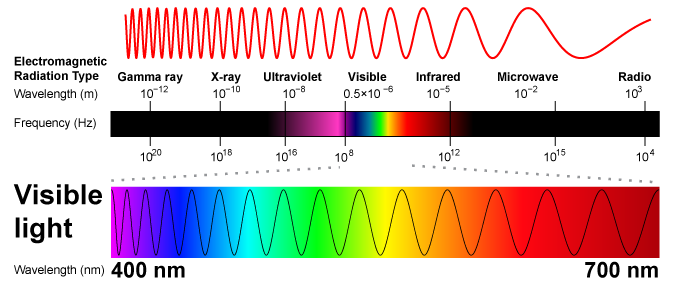
Why Do We Measure Solar Radiation?
Nearly all life on Earth starts with sunlight hitting a plant’s leaf, transforming that energy into carbohydrates that move up the food chain. The cost of receiving all that energy is transpiration, or the exhalation of water through the plant’s stomata to keep from overheating.
Arable’s solar radiation measurements estimate the crop’s vital rates: photosynthesis and transpiration. Growers are well aware of their specific crop’s need for light, and most crops are grown in field layouts that maximize their access to it. Beyond that, management considerations, such as water, nutrients, and crop protection, are controllable and generally take precedence over light.
However, while we can’t control how much sunlight the Earth receives, we can make decisions to maximize its use. How well a crop uses its accessible light tells us a lot about its health. Moreover, since different species and varieties use different amounts and qualities of light, knowing the dynamic light variables can help a grower with many field-level questions, including:
- Which species or variety should be put in which field?
- What variety has the highest light use efficiency in a trial?
- Why is one year’s crop performing better or worse when all other variables are the same?
- How do natural disasters like wildfires affect yield and quality?
Light measurements provide insight into an essential thing a crop does: converting atmospheric CO2 into organic carbons. Carbon fixation is incredibly energy-intensive; thus, plants evolved to use the energy in abundance all around them: light. The plant pigments hijack the electrons from the light molecules and transfer them onto energy molecules that fuel the carbon fixation cycle.
With the increasing efficiency of management and resource availability in agriculture, many researchers and growers find that, under controlled environments, their crop productivity is limited only by light.3
Another group of researchers found that alfalfa and corn productivity increased under the smoky conditions of high photosynthetically active radiation caused by wildfires in California.4
How Is Solar Radiation Measured?
The Arable Mark has a unique set of sensors measuring shortwave (solar) radiation in the 350–1,100 nm range. We measure the incoming energy with the upwelling spectrometer and the amount of outgoing (reflected) energy with the downwelling spectrometer.
Figure 2 presents an example of daily solar radiation (MJ/m2). Between August and September, the Arable Mark captured a drop in solar radiation due to smoke caused by the wildfires of 2020.
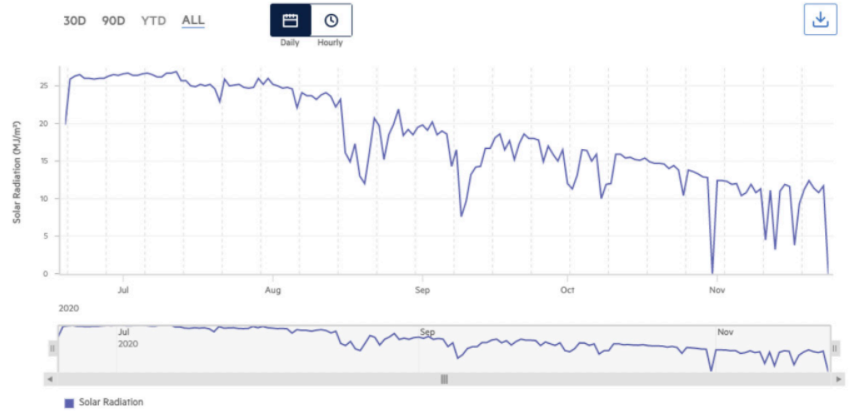
With Arable, you can keep track of your crop growth through the season using the NDVI (Normalized Difference Vegetation Index) measurement, allowing you to see how the hours of sunlight influence your field’s development.
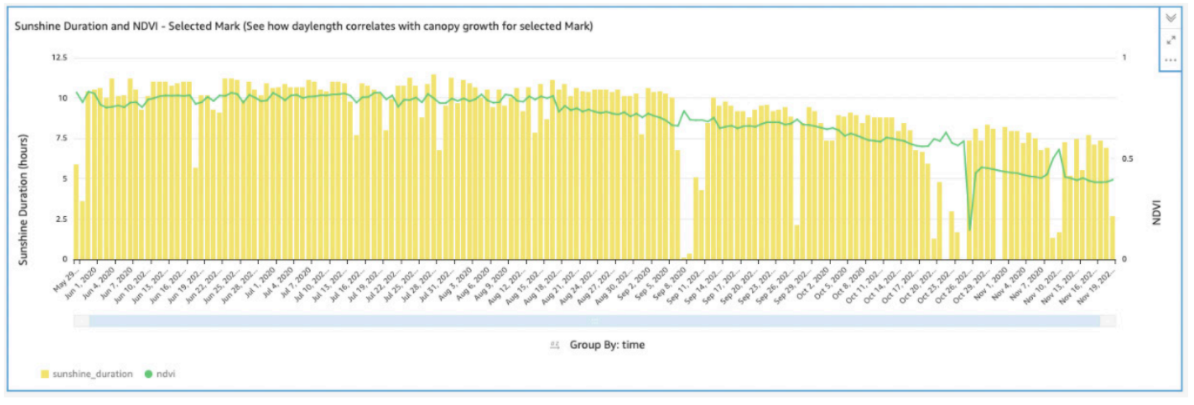
Figure 4 shows a close relationship between the duration of the day and the maturity and senescence of hops in Nebraska.
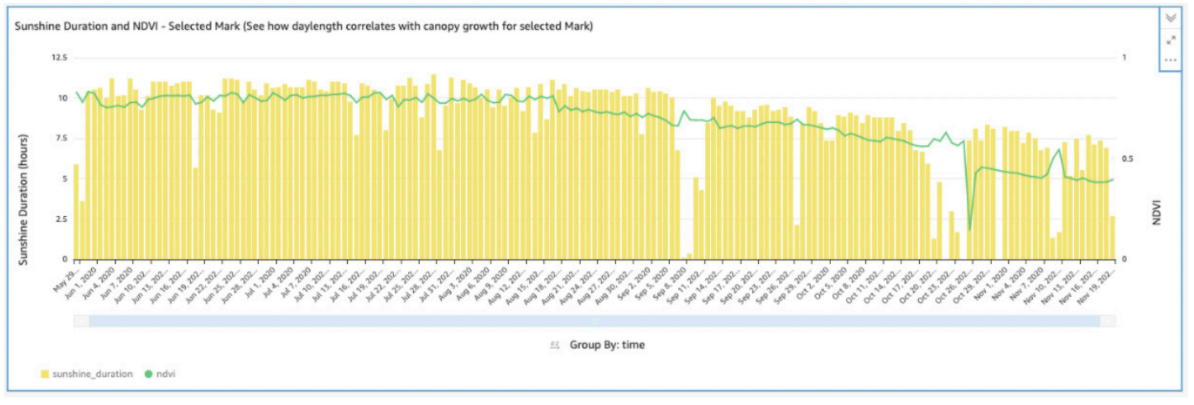
Summary
Solar radiation is a key driver of crop growth and development. Growers can effectively maximize their use by understanding how different species and varieties use light. Arable Mark’s sensors can help by enabling growers to measure solar radiation and optimize their management decisions to drive sustainable outcomes.
Citations:
- Naylor, R. E. L. “Crop Ecology: Productivity and Management in Agricultural Systems” (2nd ed.), by D. J. Connor, R. S. Loomis, and K. G. Cassman. Xii 568 Pp. Cambridge, UK: Cambridge University Press (2011). “The Journal of Agricultural Science, vol. 150, no. 2, 2012, pp. 285–285., doi:10.1017/S0021859611000852.
- Photosynthesis 3: Light and Pigments – learn-biology. (n.d.). Photosynthesis 3: Light and Pigments – Learn-Biology; learn-biology.com.
- Bugbee, B., and Monje, O. “The Limits of Crop Productivity,” BioScience, vol. 42, issue 7, July/August 1992, pp. 494–502, https://doi.org/10.2307/1311879.
- Hemes, K.S., Verfaillie, J., and Baldocchi, D.D. “Wildfire-Smoke Aerosols Lead to Increased Light Use Efficiency Among Agricultural and Restored Wetland Land Uses in California’s Central Valley,” Journal of Geophysical Research: Biogeosciences, vol. 125, issue 2, 2020, doi: 10.1029/2019JG005380.
